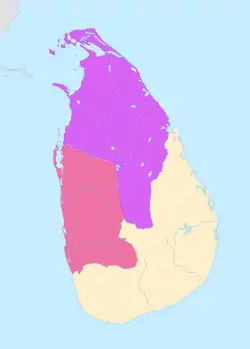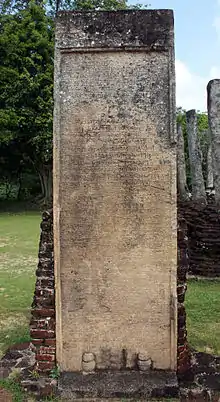Kingdom of Polonnaruwa
The Kingdom of Polonnaruwa was the Sri Lankan kingdom from which Sinhalese kings ruled the island from 1055 until 1232. Pollonnaruwa was the second administrative center of Rajarata.[3]
Kingdom of Polonnaruwa පොළොන්නරුව රාජධානිය | |||||||||||
|---|---|---|---|---|---|---|---|---|---|---|---|
| 1055–1232 | |||||||||||
 | |||||||||||
| Capital | Polonnaruwa | ||||||||||
| Common languages | Sinhala | ||||||||||
| Religion | Buddhism & Hinduism[1][2] | ||||||||||
| Government | Monarchy | ||||||||||
• 1055-1110 | Vijayabahu I | ||||||||||
• 1153-1186 | Parakramabahu I | ||||||||||
• 1187-1196 | Nissanka Malla | ||||||||||
• 1215-1232 | Kalinga Magha | ||||||||||
| Historical era | Polonnaruwa period | ||||||||||
• Established | 1055 | ||||||||||
• Disestablished | 1232 | ||||||||||
| |||||||||||
Part of a series on the |
|---|
| Historical states of Sri Lanka |
 |
|
|
Founding
The city is situated on the left bank of River Mahaweli. Archeological evidence and accounts in chronicles suggests that the city is as old as Anuradhapura. The Vijithagama settlement made by Vijitha in 400 BCE is thought to be situated near the town.
History
After ruling the country for over 1,400 years, the Kingdom of Anuradhapura fell in 1017 to the Chola King RajaRaja and his son Rajendra, who took King Mahinda V as a captive to India where he died in 1029. The Cholas shifted the capital to Polonnaruwa and ruled Sri Lanka for 53 years. Polonnaruwa was named as Jananathapuram by the Cholas. King Vijayabahu I eventually defeated the Cholas and re-established the Sinhalese lineage. Polonnaruwa had previously been an important settlement in the country, as it commanded the crossings of the Mahaweli Ganga towards Anuradhapura.
Some of the rulers of Polonnaruwa include Vijayabahu I and Parakramabahu I (Parakramabahu the Great). Most of Polonnaruwa that remains today dates from after the 1150s, as the extensive civil wars that preceded Parakramabahu's accession to the throne devastated the city. Parakrama Pandyan II from Pandyan Kingdom invaded the Kingdom of Polonnaruwa in the thirteenth century and ruled from 1212 to 1215 CE. He was succeeded by Kalinga Magha the founder of the Jaffna kingdom. Kalinga Magha ruled 21 years until he was expelled from Polonnaruwa in 1236.
Demise
The Kingdom of Polonnaruwa was abandoned in the 14th century, and the seat of government for the Sinhalese kings was moved to Dambadeniya. Although many factors contributed to this, the leading cause of the abandonment of Polonnaruwa was its susceptibility to invasions from south India.
Trade
The kings who ruled in Polonnaruwa engaged in foreign trade. During the period of king Parakramabahu I, Sri Lanka was self-sufficient in paddy and also had exported to many Southeast Asian countries as well as to India. The people of Polonnaruwa had many of their requirements fulfilled except salt, which they had to bring from the coastal area.
Religion
Buddhism continued to be the main religion in Polonnaruwa era. Before the Sinhala kings' rule, there was a strong influence of Hinduism caused by Cholas. It is evident from the removal of cow shape in Polonnaruwa moonstone and also by the presence of Shiva temples in Polonnaruwa. After Chola rule a lot of vihars were renovated by Vijayabahu I and Parakramabahu I. Various divisions or Nikayas in Buddhism were united by Parakramabahu I.
Education
The kings who ruled during this period built Buddhist schools for monks which were known as the Pirivena. And also the Brahmins were the only group which had the rights to have education. Pali and the Sanskrit were the official languages.
Gallery
 Buddha statues in Gal Vihara
Buddha statues in Gal Vihara Seven storeyed Satmahal Prasada
Seven storeyed Satmahal Prasada Moonstone of Polonnaruwa
Moonstone of Polonnaruwa Parakrama Samudra built by king Parakramabahu I
Parakrama Samudra built by king Parakramabahu I Giritale Tank was the deepest tank in Sri Lanka during Polonnaruwa era.
Giritale Tank was the deepest tank in Sri Lanka during Polonnaruwa era. Shiva Devalaya in Polonnaruwa, dating back to the early years of Chola rule in Sri Lanka.
Shiva Devalaya in Polonnaruwa, dating back to the early years of Chola rule in Sri Lanka. Polonnaruwa velaikkara (Tamil) inscription of Vijayabahu I
Polonnaruwa velaikkara (Tamil) inscription of Vijayabahu I
Notes
- Paranavitana, Senarat; Nicholas, Cyril Wace (1961). A Concise History of Ceylon. Colombo: Ceylon University Press. OCLC 465385.
- von Schroeder, Ulrich. (1990). Buddhist Sculptures of Sri Lanka. (752 p.; 1620 illustrations). Hong Kong: Visual Dharma Publications, Ltd. ISBN 962-7049-05-0
- von Schroeder, Ulrich. (1992). The Golden Age of Sculpture in Sri Lanka - Masterpieces of Buddhist and Hindu Bronzes from Museums in Sri Lanka, [catalogue of the exhibition held at the Arthur M. Sackler Gallery, Washington, D. C., 1 November 1992 – 26 September 1993]. Hong Kong: Visual Dharma Publications, Ltd. ISBN 962-7049-06-9
References
- De Silva 2014, p. 58.
- "The downfall of the Anuradhapura kingdom and South Indian influences" (PDF). Retrieved 3 January 2018.
- "Polonnaruwa". Archived from the original on 24 January 2015.
